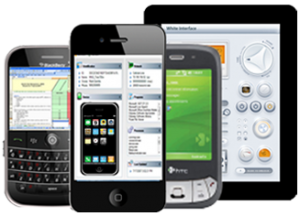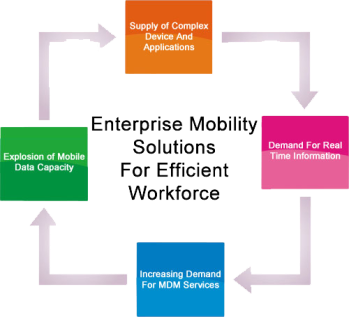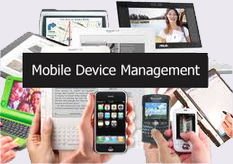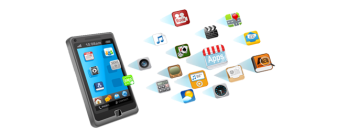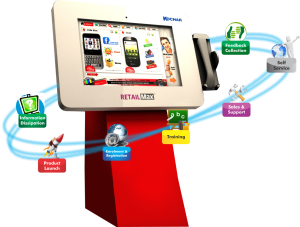BYOD is one of such inescapable phenomenon that a corporate can either adopt, or get toppled by. Popularity of Smartphones, Tablets, Fablets etc are growing since workforce now is ready to spend their own money on devices to increase their work productivity. So , no corporate would like to object to that and restrain the increasing productivity. However, every single organization irrespective of size wants these employee devices that are gradually becoming part of their work culture to be secure and manageable. Hence, having good and robust policies along with MDM solutions ready are the key steps towards making BYOD enjoyable for a corporate.
Here are some tips that will help an enterprise/corporate make BYOD effective for them:
Determine clearly how much is acceptable-
Though BYOD means that every employee can bring his/ her own device but that does not mean at all that it has to be free for all. Clearly define as an organization what devices you intend to support, what services as a corporate you can provide. Can non-corporate owned devices be connected to the internal network or they can just connect their device to guest network? Can they use all apps available on their device for official purpose?
Determine clearly what is not acceptable-
BYOD along with facilitating the productivity raise certain security risks as well if not managed appropriately. So in order to mitigate the risks it’s very necessary to clearly determine what is not acceptable inside your organization. For example- As a CIO you are comfortable if workforce access the guest wireless network with non-corporate owned device, but it’s not permitted to use official network with personal devices or connect their personal laptops or tablets to the corporate Ethernet.
IT team needs to be clear in their approach that they want to use for BYOD while simultaneously decide and declare what is not acceptable.
Determine if where can offer support and what’s your limit-
They in BYOD implies clearly that it is not corporate property, but official IT support desk is certainly going to get flooded with questions as soon as BYOD gets a green signal. Users will have questions like How to set up my official email on device? How can I access of the Intranet? How to install that app? Myriad of platforms out there is going to make it very challenging for your support desk to provide support for all.
So before you open gates for all devices clearly define and decide what as an organizational support desk you are comfortable with and clearly set expectations with the workforce.
Set up and announce your device policy-
Above three steps discussed can be made clear to the workforce through the Device Policy. Create and announce the corporate device policy which points what devices corporate will be supported, how these personal devices can be used inside corporate or for corporate work, the range of apps that are allowed, and just how far the support desk can offer its support for personal devices.
Spend time on the policy before making it public with the workforce. Make it clear to your work domain that this is what you want your workforce to spend time on so that every point is clear to them. Make sure that the policy is in written format and easily comprehensible. Make it clear that as a corporate you want employees to take privilege of BYOD yet avoid the negative impact it can place on productivity. Make it clear to the workforce that the corporate policy is applicable for personal devices as well.
Explain Security clearly-
BYOD can impact security, so make sure you talk about that clearly. Users of Exchange can use Exchange ActiveSync policies to lock devices with passwords, screen locks etc, and remotely wipe a lost device. Every device does not support hardware encryption, so as a corporate you have to decide whether you require that or not. If required then, how are going to address all those BYOD devices that won’t be allowed. Device policy covers remote wipe and your workforce should be fully aware that they are responsible for their device backups, since BYOD devices will have personal content on them as well.
Assess and choose the solution-
If you are determined that you want to go for Mobile Device Management (MDM) solution, plan an in-house evaluation session to be fully aware of the product and sure that it fits in your corporate working environment. Make sure to take the trial of the product first to test it before you buy it.
Start with a small division-
Start BYOD phase wise and conduct a pilot. For example IT teams generally have devices that support BYOD so start phase one with your IT team, then phase two with a team of limited number may be the main management team. So that you are comfortable with all the aspects of BYOD before you open it for everyone.
Evaluate –
BYOD and MDM both are solutions that need constant consideration. Both the solutions require constant evaluations to check what works, what needs to be changed and what needs to be omitted. Make it clear to workforce as well these solution are under constant evaluation changes are to be expected to ensure that the solution is functioning effectively for both users and the company.
So now you have a list of handy tips to help you begin project BYOD for your enterprise. BYOD offers significant advantages to the business and can make a big impact on workforce productivity too. Hence utilize BYOD in the best interests of the enterprise to make sure it’s a success rather than a burden.

